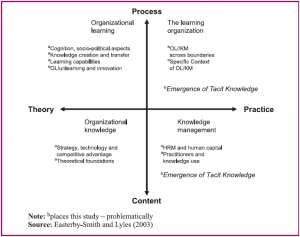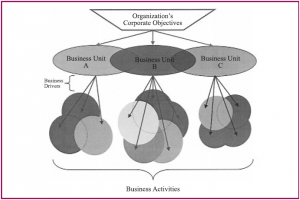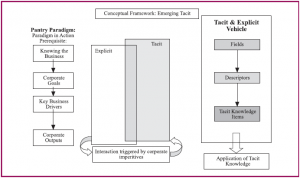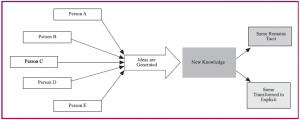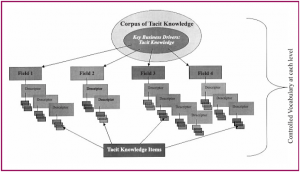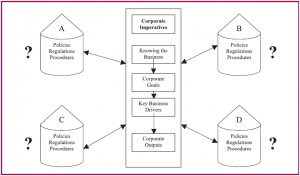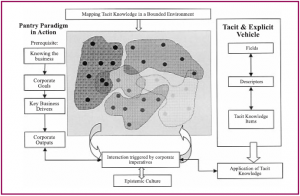Abstract
Purpose – This paper aims to report on an empirical case study, (single case multi-site) employing both a ‘‘hard’’ and ‘‘soft’’ method. The tangible, visible component of the study was the production of a database whose fields were to be the source of tacit knowledge emergence. Design/methodology/approach – The proposition was that the possibility for the capture of tacit knowledge was subject to four conditions. The first was the need for a teleological motive and purpose. The second was a bounded environment expressed in this case in terms of the published corporate goals and key business drivers. The third was the production of a controlled vocabulary that made sense to both the respondents in the context of the true nature of the business activity. The fourth and most important condition was the interactive and iterative process that allowed those involved to own the tacit knowledge emerging process.
Findings – Results supported the idea that under bounded conditions, a shared sense of purpose and an iterative process where ownership was possible, tacit knowledge could be captured. In the bounded environment tacit knowledge was found to be not haphazard, confirming its ‘‘end purpose’’ for being.
Practical implications – The findings of the research have practical application for organizations wishing to capture the tacit knowledge of their knowledge workers and describes a methodology for emerging and capturing it.
Originality/value – Is of value in presenting a method for emerging tacit knowledge in-play in abounded environment.
Keywords Tacit knowledge, Knowledge management, Knowledge capture, Database management, Controlled language construction
Paper type Research paper
Introduction
This paper focuses on the possibility of capturing tacit knowledge. Since Polyani (1962, 1966, 1967) published his seminal work on tacit knowledge, there has been an increasing interest in the topic. An interesting comment is that this is a topic that, whilst located within the knowledge management domain (Dierkes et al., 2003; Easterby-Smith and Lyles, 2003), spans disciplines as diverse as human resource management (Nonaka, 1994), organizational learning (Hedberg and Wolff, 2003; Mertins et al., 2001; Applegate et al. 1987; Takeuchi and Nonaka, 2004), media studies (Bu¨chel and Raub, 2003), social psychology (DeFillipi and Ornstein, 2003) and economics (Foss and Mahnke, 2003). Easterby-Smith and Lyles (2003), as well as presenting a meta-analysis of topics within the knowledge management domain and their likely future impacts, propose an agenda for future research in the form of a map within which we have placed the research being reported here (see Figure 1). More specifically, this research utilizes information technology in the form of a database to be used in a particular way. The database was to become a framework for a highly interactive and iterative process whose aim was to emerge tacit knowledge. (A companion study ‘‘The willingness study’’ was conducted as part of the research project but will be reported on elsewhere).
Figure 1 Framework and future research
Going into the study, the authors adopted a teleological assumption. In practice this meant that if respondents could ‘‘dredge up’’ the tacit knowledge needed to make judgements about the nature, status and placing of relationships, it could be said to have emerged. The authors delimited the study, and so any claims made for using the process-based approach were conditional on thinking of it within a bounded environment. The paper describes the development of a database to act as a trigger for the emergence and application of tacit knowledge within a bounded environment. The bounded environment consisted of the corporate business drivers that expressed valued organizational goals. The process of designing, developing and populating fields within the database was qualitative, process-oriented and above all interactive. Given the parameters of the database rationale, the users came to own many of the design and development processes. The next section outlines the thinking behind the study.
Nonaka et al. (2003, p. 491) have emphasized the importance of knowledge management citing it as an important ‘‘sustainable competitive strategy’’. However, the literature also reflects the dominance of codified explicit knowledge. The authors propose that the history of organization theory shows that foundations of structural functional thinking (Burrell and Morgan, 1979) and rational ideology informed the broader knowledge creation framework. Possibly under-appreciated within the rational ideological framework are the ‘‘acting upon’’ activities of people as they made sense of the explicit knowledge (Weick, 2001). Following Weick, the authors reasoned that the ‘‘making sense of’’ activity more reflected the Kantian notion of the a priori knowledge-processing capabilities that lie beyond knowledge inputs:
For in Kant’s view, the nature of the human mind is such that it does not passively receive sense data. Rather it actively digests and structures them, and man therefore knows objective reality precisely to the extent that reality conforms to the fundamental structures of the mind. The world addressed by science corresponds to principles in the mind because the only world available to the mind is already organized in accordance with the mind’s own processes. All human cognition in the world is channelled through the human mind’s categories (Tarnas, 1991).
For this ‘‘making sense’’ to be appreciated, contextual and relational cues interact with the factual content. Supported by many writers, the authors propose that within the seemingly impersonal and explicit world of rational management, there lives dynamic, questioning, and above all generative instincts of people at work (Argyris 1964; 1991; 1994; 1995;, 1996; Weick, 1979, 1995; Nonaka et al., 2003). A key concept was used in the design of the ‘‘Active Reflective Triggering Enabler’’ (ARTE) device the authors used to emerge (through its application) tacit knowledge. Interaction was both with the explicit content-based knowledge of the database (once it had been emerged) and the iterative processes that ran parallel to it – how it was encouraged is described later. The authors aimed to emerge internally held knowledge that they associated with the construct of tacit knowledge (Polyani, 1962; 1966; 1967; Baumard, 1999, Antal et al., 2003). They took up the challenge as to whether tacit knowledge could be emerged or surfaced but at the same time remained very interested in the speculations about the future and change (Dierkes et al., 2003). There is an assumption in some of the literature that if knowledge exists it can be captured in its totality and retrieved using an appropriate technology. Such a claim, not unexpectedly drew its detractors (Pleasants, 1996; Schuppel et al., 1998; Lubit, 2001). While this assumption may be reasonably applied to explicit knowledge, it is uncertain whether it holds true when it is applied to tacit knowledge and the authors did not think that the claim held true for the full extent of tacit knowledge. In keeping with their thinking, the authors designed into the study the concept of the constraints of the ‘‘bounded environment’’.
The authors proposed that the capture of tacit knowledge was subject to three conditions. One, the teleological motive underpinning the purpose for its capture; two, the bounded environment in which the business activity was conducted to support the corporate goals and its key business drivers; and three, a controlled vocabulary that made sense to both the respondents in the context of the true nature of the business activity. The capture of the tacit knowledge particular to this study relied upon the development of a commonly agreed vocabulary. This vocabulary coincidentally incorporated much of the corporate language used by the organization. The extractable ‘‘chunks’’ of tacit knowledge (that is extractable though their application) when emerged actually mirrored at the higher levels the organization’s key business drivers. The chunks were emerged through a process and methodology created for the study.
The thinking that went into the study was along the following lines.
In the quest for determining tacit knowledge within a ‘‘bounded environment’’ it is necessary to discover the key attributes in business. There is the imperative to conceptualise elements of the tacit knowledge domain in a teleological way. The authors needed to combine this conceptual framework with an iterative and interactive methodology to meet their aims. At the core of this study was the research task of representing the respondents’ tacit knowledge and judgments in such a way that these could be applied to both the system of the research context and in a wider sense to the respondents’ day-to-day work. The researcher was very conscious of problems discussed by Tsoukas (1998) and Chia (2003) on representational issues. The respondents were engaged in a high level of processual activity at all stages of the study.
The teleological purpose of knowledge refers to the end purpose for which knowledge is acquired and is required for the success of the business activity. It is asserted that the teleos is integral to, and implicit in, the particular key business drivers of organizations. It is against the implicit and explicit understanding of the business drivers that constructs of tacit knowledge are developed by those who are directly involved in the business activity. It will be asserted later that the constructs are formed by a framework of judgment that is held so tacitly that it has to be emerged or discovered through an iterative process grounded in the business activity itself. This process confirmed the ‘‘knowledge spiral’’ proposed by Nonaka and Takeuchi (1995).
Contextual argument for the proposition
Parameters were set for the study. In essence, respondents in the case organization developed relationships, which fell into several categories, ranging from robust to risky. As prompts to the memory, artefacts such as business cards and/or other symbols were retained by respondents. What was not available to the organization was the tacit knowledge that could be triggered by for example business drivers, symbols and/or artefacts. The authors reasoned that as the teleological purpose of the organization was set by the respective corporate goals and objectives and as these goals seemed to be well accepted, respondents would be motivated to share their tacit knowledge that was linked to key business drivers and measurable outputs. Figure 2 illustrates how all parts of a successful organization are aligned to its common corporate objectives and knowledge. The process of sharing requires a corporate language. The language used tends to be in the form of jargon, which is context specific and unique to the organization’s activities (Knorr Cetina, 1999; Stake, 2000; Shaw, 2002). It is the operating epistemic culture that relates to the specific business activity and the specific ‘‘bounded environment’’.
Figure 2 also illustrates how each of the business units A, B and C in our case organization is aligned to, and responds to, the corporate objectives of the organization. However, being separate business units each also has differing sets of outputs to achieve. These are indicated by the different shaded circles. Similarly, each business unit’s drivers are business unit-specific, consistent with the concept of the bounded environment. For example, for the marketing business unit these could relate to size of the market; characteristics of consumer base; geographical location of client bases; their industry type or group; product lines; self-selecting preferences of consumers when receiving products and services; judgment on the value of client to the business. The finance department however, might be interested in value of sales; cost of production and also, for different reasons, the size of market; market potential and product lines. This results in the degree of commonality and overlap between, and synergy with the business activities, represented by some of the shaded circles being repeated in one or more business units.
Figure 2 Overlapping drivers in organizational settings
It was from this context that a method for emerging the tacit knowledge that was in-play in the particular bounded environment was devised; this in turn confirmed the theoretical model proposed.
Theoretical model
The genesis of this thinking came from linking items in a kitchen storage cupboard of ingredients (Pantry) to the idea of explicit knowledge (recipes) and tacit knowledge (recipes þ experience). The Pantry Paradigm was coined to encourage respondents to recognize and appreciate the value and uniqueness of their own tacitly held knowledge to the particular business activity. In the process described later, a personalised analogy was used.
Tacit knowledge was likened to a ‘‘just-in-case’’ pantry (as opposed to a ‘‘just-in-time’’ one). Generally speaking, each pantry is stocked with ingredients ‘‘just-in-case’’ of need. There are some core ingredients that each pantry has, for example, pepper, salt, sugar, flour, coffee and tea. These represent codified explicit knowledge; in the Pantry (kitchen store cupboard), they are the labelled ingredients from which a selection is made ‘‘just-in-time’’. Representing tacit knowledge is the judgement of the cook in selecting and combining ingredients with a vision of the finished product in mind. For example, the order in which ingredients are combined; the significance of colour or consistency or moisture in relation to the progress of the end dish; the length of cooking time; the need to connect smell with results; the ability to discriminate between ’’beautifully brown and burnt’’; all, to some extent, rely on tacit knowledge taken so much for granted. Judgment plays an important role in tacit knowledge. Judgment is formed on the basis of experience, trial and error, tip sharing, advice, practice and the basic principles of physics that contribute to culinary success. There is(doubt that in the cooking process both explicit and tacit knowledge are invaluable, however, as they are each different in nature, they have differing roles. Tacit knowledge emergence begins not from the pantry of ingredients, but rather unbundling the essential ingredients that went into the making of the blue ribbon winning sponge.
Members of a work group have a metaphorical pantry of ingredients in their heads – their tacit knowledge. Each component of this tacit knowledge has, as its beginning, a combination of experience, education, technical knowledge, and cultural values (Eden and Spender, 1998). These contribute to the development of discrimination and judgment. In the organizational setting, tacit knowledge can be emerged in relation to the aspects required to do the job. The content and key aspects of the tacit knowledge held, and needed, to get the job done and to work together productively may be unstated because some things are ’’just known’’ (Giddens, 1984), perhaps with the holder of the knowledge not even consciously aware of his/her knowing. Polanyi (1962; 1966) summed this up elegantly when he reminded us that each of us knows more than we can know we know. The authors placed the pantry metaphor within the concept of the organization. They considered ‘‘key ingredients’’ to be the organization’s business drivers. ‘‘Ingredients’’ are the data that are applied to making decisions. The intellectual process involved in the combination of ingredients with business drivers is equivalent to the cooking process in the pantry paradigm. The combination is determined by the outcome sought.
A conclusion of this study was that a ‘‘Framework of Tacit Judgment’’ was unconsciously applied in the ‘‘bounded environment’’ by the respondents as they went about their day-to-day business activities. Figure 3 diagrammatically summarizes the three conceptual parts of the ‘‘Framework of Tacit Judgment’’:
- the analogy of the Pantry Paradigm is used;
- the existence and use of tacit and explicit knowledge is acknowledged, each corpus interacts with, and is triggered by, the particular corporate imperatives, resulting almost inevitably in the creation of new tacit knowledge as explicit knowledge is applied and re-applied to the business activity; and
- the ‘‘Tacit and Explicit Vehicle’’ is the language used by those who are involved in the business activity in the organization, through both the formal and informal use language that can be categorized as: Fields, Descriptors and Tacit Knowledge Items.
Figure 3 ‘‘Framework of Tacit Judgment’’
Where knowledge workers are gathered together in a business activity, the sharing of even the same ‘‘ingredients’’ can result in ideas being generated collectively, and also separately, nevertheless adding to ‘‘new knowledge creation’’. Part of this might be made explicit through a codification process IF a process is in place. Other less tangible parts remain tacitly held by people until such time as they emerge or are ‘‘triggered’’. The process then starts again, as we depict in Figure 4.
Figure 4 ‘‘Framework of Tacit Judgment’’ continued
The study
The study was conducted in one area of a large national public utility. The organization (used to refer to this area, rather than the national utility) interfaced with its marketplace in such a way that knowledge of relationships held and managed were tacit in nature and furthermore were very much taken for granted. The organization was vulnerable to loss through people leaving. This research aimed to emerge a discrete part of the tacit knowledge held by the staff by virtue of their business activity. This was seen to provide a ‘‘bounded environment’’ for the study. The first step in the study was to understand the criteria against which respondents judged their relationships, to be appropriate or otherwise for their business activity. In other words, the researcher needed to penetrate the ‘‘process-of-knowing’’ that was integral to the respondents’ teleological purpose of organizational being (Sveiby, 1997). Whiteley (2002, p. 8) suggests that the purpose of research design in a study is to ‘‘provide the logical sequence that connects the field data to a study’s initial research question and ultimately to its conclusions. . . . the rationale for the research must follow a plausible pattern and the sequencing must do the same’’.
The research design for this study had four major components.
The first component was the use of the case method. Stake (2000), Creswell (2003) and Yin (1994) confirm the appropriateness of using case method when the researcher is exploring in depth a program, activity or process; and where the case is bounded by time and conducted within a time span. The activity being studied required the researcher to collect detailed information using a variety of data collection procedures over a sustained period.
The second component was a constructed set of categories embedded in a database. The database provided the repository for the emerged tacit knowledge, which was ‘‘dredged-up’’ and converted into its explicated form. Categories that were emerged and presented were then validated within an iterative process involving tacit-knowledge holders.
The third component was the tacit knowledge itself: knowledge that was grounded in the respondents’ theories, experiences and ways of making sense of information (such as those on business cards) in their business context.
The fourth component revolved around the willingness of respondents to declare, and share, their tacit knowledge for use in their specific work domain (referred to as their bounded environment in this study), if they were enabled by an appropriate technology.
It was decided that although the principles of grounded theory and grounded research were still central to the interaction with respondents so that they could use, emerge and apply tacit knowledge, this perspective did not fulfill all of the research needs. The researcher planned to be participative within the study which evolved to an organizational intervention (albeit in a grounded way) as the research proceeded. This put the research firmly in the domain of action research (Lewin, 1951; Argyris, 1995) but more accurately participatory action research (Heron and Reason, 1997; Lincoln and Guba, 2000) with the researcher firmly ‘‘within’’ the research context. The database would be ‘‘specified’’ and developed by the researcher in an integrative way. This meant that the participant observer role needed to be taken. From a positive standpoint, aspects such as being close to the language and epistemic culture of the respondents (Knorr Cetina, 1999) were of benefit. In particular, culture as manifested in the use of ‘‘in-house’’ jargon in the research site was accessible to the researcher. Caution needed to be taken, however, to preserve the relative objectivity needed to focus on the research. Heron and Reason’s (1997) ‘‘cooperative paradigm’’ model allows for categories to be ‘‘fluid, altering and enlarging’’ where boundaries are constantly shifting. ‘‘Meaning-making activities’’ referred to by Lincoln and Guba (2000, p. 167), have parallels in this study. In their terms, these activities have attributes that can shape both action and inaction.
It was the researcher’s intention to hear the story of the respondents, as it applied to their business activities and the key business drivers to which they aligned their activities. This was their ‘‘lived experience.’’ The ‘‘life world’’, in this research context, was the content and topics of the tacit knowledge held by the respondents and considered to be part of a complex social setting. The research was designed to give respondents ‘‘voice’’ through the iterative processes that gave findings an emergent focus. The emergent methodology was to identify socially stable constructs in the research context and to work within some readymade categories that were observed to be ‘‘in play’’ during the preliminary fieldwork.
Nevertheless, allowances were made for each stage of the data collection to inform the next stage and to allow for continuous modification of the research design. These factors required the researcher to take an open and flexible position with as few assumptions as possible governing the data collection or data analysis. Systematic procedures governed each stage and ensured the connections between the stages of the research design (Whiteley, 2002).
In the initial stages of the study several things were noticed. First, the sharing of tacit knowledge appeared to be freely given. Next, there appeared to be a ‘‘jargon’’ used of shorthand descriptors. There was a complex protocol underpinning the sharing that was implicitly understood by the group, even though the protocols were not codified (Shaw, 2002). These seemed to have a link to the organization’s key business drivers. Many of the conversations observed had a repetitive quality about them and we judged that there was a discernible epistemic culture (Knorr Cetina, 1999). Critically, however, there was no process for the knowledge to be shared or to be captured for re-use. The practical benefit of being able to capture the knowledge shared on a just-in-case basis was enticing. The objective was that input and retrieval should simulate real-time sharing, rather than be in qualitative, prose format, diary notes or file notes in natural, unstructured language. It was quickly recognized that an IT-based enabling device would allow equally for just-in-case input and just-in-time retrieval.
Developing the Active Reflective Triggering Enabler (ARTE) through an interactive process-oriented methodology
Using an iterative process, several tasks were completed. A database was constructed, housed on the organization’s server and accessible from respondents’ desktop computers. Here, items of tacit knowledge could be inputted. A controlled vocabulary was necessary. On the one hand the controlled vocabulary had to be emerged from the respondents themselves through an iterative, grounded method, and on the other, the controlled vocabulary would have to make sense to each person in the total group. A method to arrive at consensus of meaning was devised, including a method for agreeing to the definitions of each termused, to ensure sustainable consistency in the end-to-end process of capture and retrieval. It was anticipated that if this proved successful, it would result in a controlled vocabulary that would also serve as an enabler for the triggering, prompting and recall of the tacit knowledge held by respondents. Activities that occurred in the research site were mapped to a schema that eventually led to the embedding of the categories as fields, in the online Active-Reflective Triggering Enabling database. The active-reflective intellectual process was the starting point of the propositions posed for this study. The process took the researcher out on many exploratory tangents, but, at the end of each ‘‘journey. a return was made to the core set of propositions. The researcher had to come to terms with a paradox; although the ‘‘journey’’ was empirical it was of itself tacit in nature. It required a duality of thinking to contemplate such a contradiction. Nevertheless, the paradigmatic nature of this study did require and provided many milestones that were concrete.
Building the system architecture
Wittgenstein (in Hassard, 1988), makes the distinction that:
. . . language is a social activity expressive of human needs, a means of communication is within the world, and not merely a reflection of the order of the world. . . . language is part of an activity, or of a ‘‘form of life’’. [Wittgenstein’s thesis] that language is both a product of human activity and a producer of meaning, and thus of new forms of human action (Hassard, 1988, p. 254).
The relationships between the ‘‘tacit knowledge items’’ were mapped to ensure that what was retrieved made sense and was valid to the business activity. A three-tiered web application which used VB (Visual Basic) script, plus Java, plus Active e-control and COM for a SQL Server was written. The full scope and scale of the organization’s business activities were reviewed: how each aspect related to the other; which of the descriptors best described each part of the overall business activity; and the way each descriptor could be laid out to prompt respondents as they recorded their entries. The prompts provided the context of the business activity. In some fields, multiple choice was appropriate, in others an ‘‘either/or’’ choice was ‘‘forced’’. At all times, the following issues were considered in the design phase of the system:
- What was being collected?
- Why was it necessary to collect it?
- How was the data going to be retrieved?
- Where should Fields and Descriptors appear on the screens?
- What was behind the logic of the questions being asked?
- While online help buttons were provided, the interface had to be user friendly and intuitive.
- Length of the screens with respect to user acceptability; two clicks were considered the optimum.
- User acceptability of protocols for data entry.
- The simulation of common practice was the preference.
- Technical functionality of the system-build.
- Length of time it would take to build an optimum solution in comparison to the ideal solution.
The concept of compulsory fields was introduced, to ensure that the core data required to support the business activity were provided by respondents. The design had to ensure that the database would not just become a listing of business cards or other artefacts. The tacit knowledge sought related to the potential leveraging activities behind the artefacts and this was fundamental to the teleological purpose of the database. The ‘‘tacitness’’ of the data related to the judgment applied by the respondent against the particular body of knowledge that was contingent on the business activity. The controlled vocabulary provided served as a trigger to prompt the emergence of the tacit knowledge as it related to the business activities. The data collected would add to the collective organizational memory. It followed that tacit knowledge was complementary to explicit knowledge and the value of tacit knowledge was in its meaning-enhancing qualities. The process of interpreting incoming data from conversations is the cornerstone in knowledge development. Data were automatically analysed at the input stage, as respondents ‘‘found’’ a place to input their tacit knowledge item. Figure 5 ‘‘the hierarchy’’ and relationship between the field, descriptors and tacit knowledge items in the schema that were created to provide the framework for description of the corporate tacit knowledge held in the bounded environment.
Figure 5 Hierarchy of tacit knowledge
The predetermined fields were labelled with category headings. The fields reflected the way in which the organization profiled its client base for its business activity. Respondents could sub-segment their client base by descriptors in planning service delivery. All fields and descriptors were operationally defined in consultation with respondents to ensure consistent ‘‘sense making’’. The controlled vocabulary ensured integrity of data inputted and subsequently retrieved. The recognition from the onset was that there was, in epistemic cultures, a particular knowledge that was valued in the bounded environment. This was supported by the findings of this study. Tacit knowledge was found to be ‘‘not haphazard’’ in this business environment. Each business unit in the organization worked towards its overall corporate goals and objectives. Furthermore, each business unit had a sense of the overall key business drivers, which were articulated through, and by, the business unit’s business activities, in other words: their teleos or end purposes for being.
Ingredients of codified knowledge, alluded to in the ‘‘Pantry Paradigm’’, were applied on the one hand tacitly, but against the backdrop of knowledge (some explicit such as policies, regulations and procedures) of the business, its corporate goals and key business drivers. This on reflection was considered to be more so, especially in organizations where knowledge workers apply and even transform codified knowledge through a process of application of their personalized knowledge. The transformation occurs through the application of a ‘‘framework of tacit judgment’’ that is not always transparent. The ‘‘tacit world’’ of these workers can be characterised by the unattended, unresolved, unmanaged and unconscious application of ‘‘frameworks of judgment’’ as they operate in ‘‘silos’’. A conclusion from this observation was that when organizations seek to capture tacit knowledge they are perhaps more seeking to uncover the ‘‘frameworks of judgment’’ that are being invisibly applied by their knowledge workers. In Figure 6, the traditional application of codified knowledge within an organization is illustrated. It operates to sets of policies, regulations and procedures to influence the business outcomes and activities in a predictable way. While tacit knowledge is(doubt applied, it is not made visible through any emergence process. This is reflected by the question marks depicting the questions people ask and the answers they come to, by the individuals, in making sense of the internal codified knowledge. The frameworks of judgments if they are applied in this process are therefore individual, unique, ad hoc and unimitable as the judgment applied is ‘‘unemerged’’ and invisible.
Figure 6 Traditional application of codified knowledge
As illustrated in Figure 6, each of the silos A, B, C and D, share a common theme of corporate imperatives. However, there are social spaces between the silos, where people must, and do, operate. These the authors called the tacit interface domain. The domain is characterized by tacit relationships, social exchanges, queries and questions and other ‘‘sense-making’’ activities. The domain is rich in un-stated meaning, represented by question marks in Figure 6. In this domain the spaces are invisible, but in reality, filled with tacit knowledge that although ‘‘unmerged’’ is nonetheless always present. This study sought principally to emerge this particular tacit knowledge. The results are modeled in Figure 7, where the teleological model is underpinned by the epistemic culture in which the business activity is conducted. This confirmed the ‘‘bounded environment’’ concept for the research.
Figure 7 ‘‘Islands of tacit knowledge’’: a teleological model
The model puts into action the ‘‘Pantry Paradigm’’ where several ingredients are uniquely combined with tacit knowledge to create discernible outcomes. In the organizational context where the business activity requires the application of tacit knowledge (experience) by those engaged in it knowledge of the essence of knowing the business comes from understanding of the corporate goals (recipes) that are used as the key business drivers (ingredients) to deliver on the corporate outputs for which the organizational unit is accountable (the dish). This interaction, which is in essence triggered by many corporate imperatives, is informed by the epistemic culture and the application of frameworks of judgment that are founded on tacit knowledge. In reviewing the tacit knowledge applied it was found to contain many ‘‘knowledge items’’ that could be categorised or chunked up as discrete bundles but which nevertheless had common elements. This was explained by the operating corporate goals and key business drivers that were fundamental to the ‘‘end-purpose’’ of all the business activities in this bounded environment. A vehicle was devised for emerging and making visible this particular tacit knowledge and the categorisation of the individual ‘‘tacit knowledge items’’, after they were emerged, by ‘‘descriptors’’ and ‘‘fields’’. A vehicle to make the tacit knowledge explicit was the creation of a database. This codification for the purpose of ongoing input and retrieval of tacit knowledge by the very fields, descriptors and knowledge items ensured the ‘‘sense-making’’ to the users of the database.
Figures 6 and 7 illustrate the business unit’s business drivers as they relate to the teleological intent of the organization’s corporate objectives. Figure 7 builds on that ‘‘Framework’’ and the findings of this study. It demonstrates that sitting within these overlapping contextual business environments are ‘‘islands of tacit knowledge. each having its own ‘‘particular tacit knowledge items’’ that reflect the tacit knowledge as it is applied to each explicit environment. The content of each ‘‘island. before the findings emerged, was taken to be unique, however this view was modified after the study. This is illustrated in the model (Figure 7) by the overlapping islands.
Data collection and results
The data collection demonstrates the variety of data collection procedures employed over the sustained two-year period of the study. This was in keeping with one of the criterion discussed by Cresswell (2003) who suggested that where a variety of data collection methods were necessary to serve the purposes of the study, the case method could be gainfully employed.
Stage 1. Preliminary observation of the business activity
- Activities mapped to a schema.
- Tacit knowledge ‘‘dumped’’ in natural language.
- Categories derived from descriptions of tacit knowledge that eventually led to the embedding of the categories as fields.
Stage 2. Spreadsheets used to sort categories, allow for further dumping of tacit knowledge items in Site 1
- Further refinement of categories, and new categories added to the list of controlled vocabulary. Respondents in Site 2 used to validate controlled vocabulary and ‘‘dump’’ their tacit knowledge to test cross border applicability.
- Operational definitions applied to each descriptor in the controlled vocabulary after consensus reached with respondents. Demonstration to management that business activity could be captured and manipulated to suit corporate objectives.
Stage 3. Prototype developed
Prototype specified and built for proof of concept that tacit knowledge could be categorised, described and willingly ‘‘dumped’’ and retrieved against business drivers using Boolean logic. Discrimination and judgement and were required to populate the database and build the prototype. Respondents from the second site tested the prototype and added to the records by inputting their tacit knowledge.
- Respondents in Sites 1 and 2 populated the prototype database. Categories were further refined, added to and made sense of. Four additional respondents in Sites 3 and 4 included in the study to ‘‘cold test’’ the prototype and review controlled vocabulary for sense making.
Stage 4. Proof of concept accepted
- Online database approved for system build.
- It was recommended that the database be housed on the Agency’s IT platform on its intranet in order that it would be readily accessible to each respondent at their work point.
Discussion and conclusion
Implicit in the evolution of this study was the fact that the process of discovery was embedded in the findings, even to the point of saying that the process of discovery and findings were embedded in each other. This was supported by the work of Swart and Pye (2002) on collective tacit knowledge, in which they describe how their respondents referred to ‘‘representations’’ they held of what they perceived to be ‘‘embodied patterns of interrelation’’. Respondents were found to speak in metaphors and describe the ‘‘tacitness’’ of their knowledge as more a ‘‘feeling of knowing,’’ which Swart and Pye (2002) found to be more ‘‘an expression of and action upon a complex, rich picture or map of interrelations that are embedded in the organization’’ (Swart and Pye, 2002, pp. 11-12) (Author’s italics). The underlying aspects to this insight are that representations shaped by actions, which lead to the process of ‘‘re-description’’ and this concept, is illustrated by:
. . . the combination of reshaping and guidance, depicts how action re-describes (shapes and guides) representation and vice versa. . . . there is a tension between action and representation which is due to the action-orientated nature of CTK (Collective Tacit Knowledge): that is, holding representations of embedded patterns of action may guide and shape collective action, while the very nature of the action will reshape CTK and its representation (Swart and Pye, 2002, pp. 11-12) (Author’s italics).
The important aspect in the Swart and Pye (2002) study is that it reflected the inter-twined nature of collective tacit knowledge and its description. In the researcher’s study, the description of tacit knowledge was by way of a controlled vocabulary, which was grounded and shaped through the collective sense making of respondents. Therefore, the description of this study is reported as it occurred and evolved through the interaction with: the literature; the respondents; and, the active participation of the researcher. The realization that the search for the emergence of tacit knowledge and its capture might be more related to the framework of tacit judgment applied by individuals in a discrete business activity was significant. The grounded iterative method applied to the propositions set for the research proved successful and provided a methodology that could be replicated.
The elegant assertion that people do not always know what they know (Polanyi, 1962) was also proven in the study, and further validated the method used for emergence and capture of tacit knowledge. While the criteria used for making judgments about the potential of relationships was the particular topic of this study, it is suggested the methodology created is robust enough to be applied to other contexts where knowledge work is expertly transacted. The management reports that were drawn from the database resulted in making this invisible corporate activity both visible and accountable was a key benefit of the project to the organization. A controlled vocabulary served the dual purpose of describing the knowledge items that identified the topic or content of the tacit knowledge captured actively and triggered the recall of tacit knowledge held, much like recipes in the metaphor of the Pantry Paradigm. This was also confirmed.

